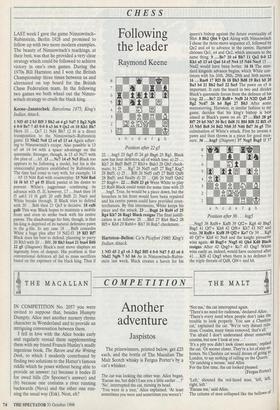CHESS
Following the leader
Raymond Keene
LAST week I gave the game Nimzowitsch- Rubinstein, Berlin 1928 and promised to follow up with two more modern examples. The beauty of Nimzowitsch's teachings, at their best, was that he provided a very clear strategy which could be followed to achieve victory in one's own games. During the 1970s Bill Hartston and I won the British Championship three times between us and alternated on top board for the British Chess Federation team. In the following two games we both wheel out the Nimzo- witsch strategy to crush the black king.
Keene—Janatschek: Barcelona 1975; King's Indian Attack.
1 Nf3 d5 2 b3 Bf5 3 Bb2 e6 4 g3 Nd7 5 Bg2 Ngf6 6 0-0 Be7 7 d3 0-0 8 e3 h6 9 Qe2 c6 10 Khl Bh7 Here 10 ... Qc7 11 Nd4 Bh7 12 f4 is a direct transpo,sition to the Nimzowitsch—Rubinstein game. 11 Nbd2 Ne8 12 e4 a5 13 a4 Again adher- ing to Nimzowitsch's recipe. Also possible is 13 a3 a4 14 b4 with a space advantage on the queenside. Stronger, though, is 13 a3 Nc7! with the plan of ... b5. 13 ...Nc7 14 e5 Nc5 Black too appears to be following a model, but his is the unsuccessful pattern established by Rubinstein. The time had come to vary with, for example, 14 ...b5 15 Nd4 Ra6 with counterplay. 15 Nd4 Ra6 16 14 b5 17 g4 f5 Black panics in his desire to prevent White's juggernaut continuing its advance with f5. If, however, 17 ...bxa4 then 18 f5 axb3 19 f6 gxf6 20 exf6 Bxf6 21 Nxc6 and White breaks through. If Black tries to defend with 20 ...Bd6 then 21 Qe3 is decisive. 18 exf6 gxf6 This way Black hopes to maintain a mobile front and even to strike back with his centre pawns. The disadvantage for him, though, is that his king is deprived of its natural defensive pawn in the g-file. In any case 18 ...Bxf6 concedes White a huge plus after 19 Nd2-f3. 19 Rf3 Rf7 Black does his best to defend, planning to parry 20 Rh3 with 20 ... Bf8. 20 Bh3 bxa4 21 bxa4 Bd6 22 g5 (Diagram) Black's next move displays an ingenuity born of despair. His problem is that conventional defences all fail to mass sacrifices based on the exposure of the black king. Thus if
Position after 22 g5
22 ... hxg5 23 fxg5 f5 24 g6 Bxg6 25 Rgl. Black now has four defences, all of which lose: a) 25 ... Kh7 26 Bxf5 Bxf5 27 Rh3+ Bxh3 28 Qh5 check- mate; b) 25 ...Rg7 26 NxfS exf5 27 Bxg7 Kxg7 28 BxfS; c) 25 Rf6 26 NxfS exf5 27 Bxf6 Qxf6 28 BxfS; and finally d) 25 Qf6 26 Nxf5 Qxb2 27 Rxg6+. 22 ...Bxf4 23 g6 Were White to play 23 Rxf4 Black could resist for some time with 23 hxg5. True, he would be a piece down, but the breaches in his front would have been repaired and his centre pawns could have provided coun- terchances. By this intermezzo, White keeps his piece and the attack. 23 ... Bxg6 24 Rxf4 e5 25 Rg4 Kh7 26 Ragl Black resigns The final justifi- cation is as follows: 26 ...Bh5 27 Rh4 Bxe2 28 Bf5+ Kh8 29 Rxh6 + Rh7 30 Rxh7 checkmate.
Hartston—Bellon: Ca'n Picafort 1980; King's Indian Attack.
1 Nf3 d5 2 g3 c6 3 Bg2 Bf5 4 0-0 Nd7 5 d3 e6 6 Nbd2 Ngf6 7 b3 h6 As in Nimzowitsch—Rubin- stein last week, Black creates a haven for his queen's bishop against the future eventuality of Nh4. 8 Bb2 Qb6 9 Qel Along with Nimzowitsch
I chose the three-move sequence e3, followed by Qe2 and e4 to advance in the centre. Hartston chooses Qel, e4 and Qe2, which amounts to the same thing. 9 ...Be7 10 e4 Bh7 11 Qe2 0-0 12 Khl a5 13 a4 Qa6 14 e5 Ne4 15 Nd4 Nec5 15 ... Nxd2 would have been better. 16 f4 The stan- dard kingside advance begins, which White con- tinues with his 26th, 28th, 29th and 36th moves. 16 ... Rae8 17 Rf3 f6 18 Bh3 Bd8 19 Rel b5 20 Ba3 b4 21 Bb2 fxe5 22 fxe5 The pawn on e5 is important. It cuts the board in two and divides Black's queenside forces from the defence of his king. 22 ... Bc7 23 Rxf8+ NxfS 24 N2f3 Qa8 25 Bg2 Ncd7 26 h4 Bg6 27 Bh3 After some manoeuvring, Hartston, in similar fashion to my game, decides that his king's bishop is best aimed at Black's pawn on e6. 27 ...Bh5 28 g4 Br 29 h5 Nh7 30 Bc1 Bd8 31 Bf4 Rf8 32 Rfl c5 33 Nb5 Be8 34 Bd2 Nb8 35 Nd6 Bd7 36 g5 The culmination of White's attack. First he invests a pawn and then throws in a piece for good mea- sure. 36 ... hxg5 (Diagram) 37 Nxg5 Bxg5 If 37
Position after 36 . . . hxg5
Nxg5 38 Rxf8+ Kxf8 39 Qf2+ Kg8 40 Bxg5 Bxg5 41 Qf7+ Kh8 42 0f8+ Kh7 43 Nf7 and wins. 38 Rxf8+ ICx18 39 Qf2+ Ke7 Or 39 ...Kg8 40 Qf7+ Kh8 41 Ne8 and the knight pirouette wins again. 40 Bxg5+ Nxg5 41 Qh4 Kd8 Black resigns After 42 Qxg5 + Kc7 43 Qxg7 White wins easily as, indeed, would have occurred after 41 ... Kf8 42 Qxg5 when there is no defence to the triple threats of Qd8, Qf4+ and h6.


















































































 Previous page
Previous page